
They will save us! Russian Expeditionary Force in France
/ Главная / Russkiy Mir Foundation / Publications / They will save us! Russian Expeditionary Force in FranceThey will save us! Russian Expeditionary Force in France
Yulia Goryacheva
In accordance with the Franco-Russian military convention dated 1892, our countries were allies in the war always referred to as the Great War in France and as the Second Patriotic War in the Tsarist Russia. We call that cruel war the First World War. This year marks the 100th anniversary of the First World War’s ending.
Soldiers and officers of the Russian Expeditionary Force fought for the French Republic back in 1916 – 1918 demonstrating bravery and self-sacrifice, many of them losing lives. The bodies of the majority of the soldiers have never been found. Today Russia opens unfairly forgotten pages of our country’s participation in the First World War. The Russkiy Mir Foundation presents to its readers an article written by Yulia Goryacheva about the Russian Expeditionary Force in France.
An obelisk in commemoration of warriors from the Russian Expeditionary Force was solemnly unveiled on May 29 2018 in France on Mont Spen height. A century ago, in April 1917, the 3d brigade of the Russian Expeditionary Force conquered inaccessible height of Mont Spen after fierce hand-to-hand fighting. There were around 2000 of casualties, the Russian soldiers and officers were killed, wounded and gone missing during these fights. This obelisk is already the 7th memorial erected by the Russian Military Historical Society in France.
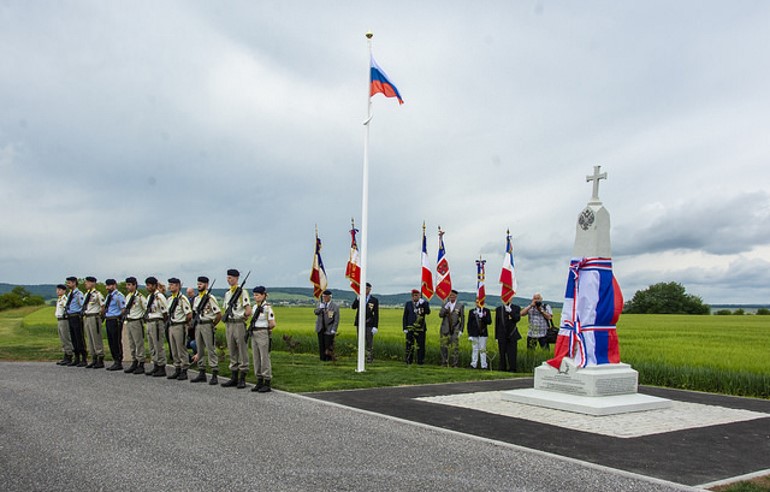
Gala unveiling ceremony near the obelisk at Mont Spen height. Picture: rusoch.fr
Several years earlier, on June 21 2011, Memorial to Soldiers and Officers of the Russian Expeditionary Force was unveiled in the center of Paris, not far from Alexander 3 bridge, in whose rule the Franco-Russian Alliance had mutual obligations in case of military attack on any of the parties.
An officer made of bronze is wearing Russian military uniform and holding a French helmet with the Russian double-headed eagle. Russian soldiers of the Expeditionary Regiment used to wear such helmets. A horse drinking water stands nearby. The authors of the composition called the Spring under guidance of the honored painter of the Russian Federation sculptor Surovtsev emphasized a dream of the officer about peace and his memory of the dead comrades-in-arms.
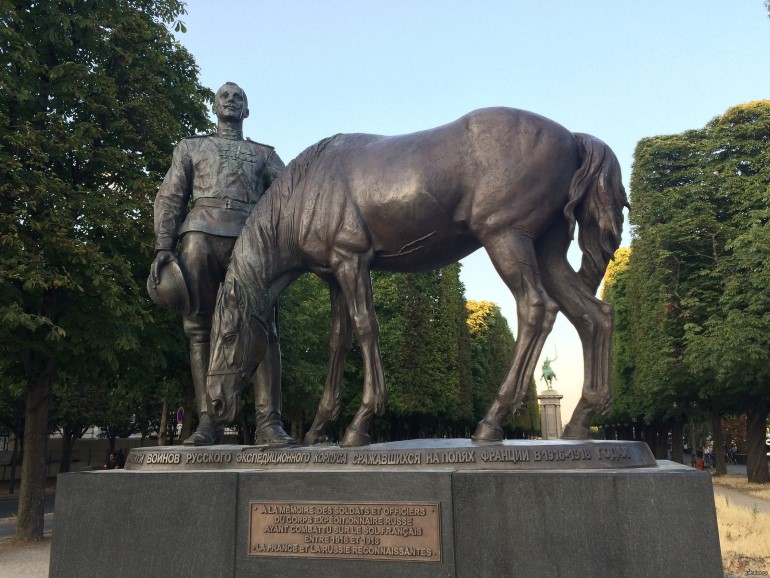
Memorial to warriors of the Russian Expeditionary Force in Paris. Source: pikabu.ru
One of the heroes of the Great War, the French Marshal Ferdinand Foch wrote that France was not erased from the map of Europe due to courage and tenacity of the Russian soldiers. These words are saturated with deep respect to Russia, the Russian Army and the Russian people. This military chronicle talks about the deed of the Russian Expeditionary Force’s fighters – 20 000 of them were fighting here in France. “Russian battalions were in the center of the military actions, in the very heat of the war. They showed great endurance in defense and unseen heroism in advances,” Vladimir Putin said unveiling the memorial.
The war started in 1914 and had delayed consequences bringing immense losses. Russia’s allies the French and the English failed to break through the solid German line. It is a well-known fact that the French commanders have repeatedly sent requests to the Russian General Headquarters about reinforcing a frontline with living force. In Autumn of 1915, the Russian military mission in Paris noted that appearance of the Russian soldiers at the Western frontline would have great moral significance raising the allies’ spirits and would become an unpleasant surprise for the Germans.
Russian giants
Tall experienced soldiers were enrolled to the Russian Expeditionary Force, preferably the Orthodox Christians. A military structure of the Force and commanders of the brigades were approved at the top level by the Tsar’s order. The first brigade included two regiments consisting of three battalions and four machine-gun squadrons each, two machine-gun squadrons of the brigade size, march battalion of six squadrons with two reserve machine-gun teams. The total number of the fighters of the first brigade was 10 500 people.
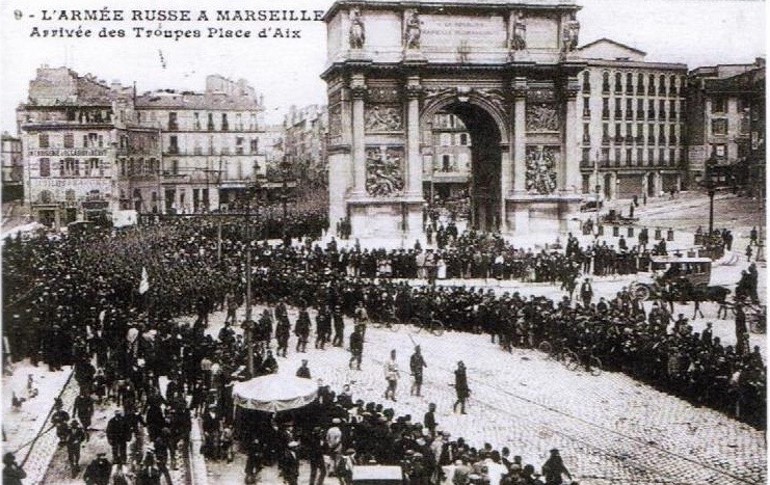
The Russian Army in Marseille, 1916. Picture from René Guerre’s collection
Four separate infantry brigades of 750 officers and 45 000 soldiers under guidance of generals Lokhvitsy, Marushevsky and Leontyev were sent to Europe at different times. The first brigade of Lokhvitsky General was sent from Moscow in February of 1916 to go through the Urals, Siberia, Manchuria right to Dailren, Japan (Dalniy) and further through seas and oceans to France where the brigade made a landing in the western port of Brest and later in Marseille, from where the second and the fourth brigades were transported to the Balkans and Thessaloniki.
The French met the Russians in Marseille singing the Russia’s national anthem and holding the guard of honor with participation of hussars’ squadron. The Marseillaise and Russian hurrays sounded in response. Singing the song called - It happened near Poltava… under the Peter’s flag, the soldiers’ troops marched on to the temporary camps.
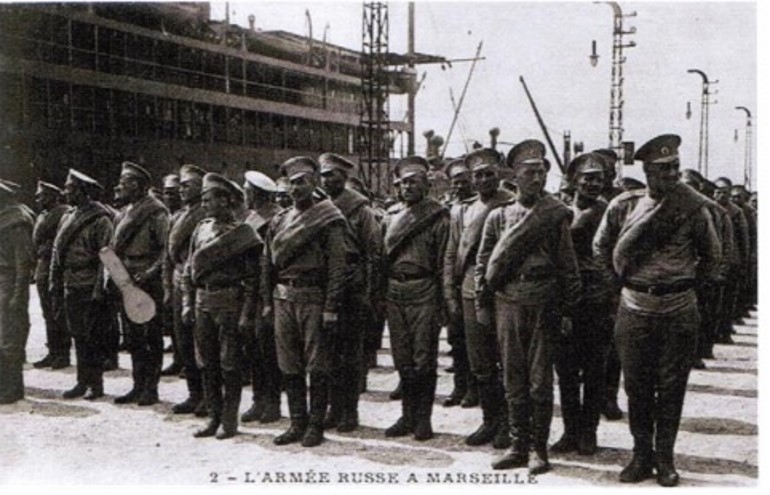
The Russian Army in Marseille, 1916. Picture from René Guerre’s collection
The battalions of the Russian volunteers solemnly marched the next day. Witnesses noted that it was a scene, which is hard to forget. A bright multi-colored ribbon of the Russian giants was marching from the port’s harbor to the city center. Bunches of flowers were carried before each battalion and each squadron. Each officer had a carnation on his breast and a flower in the barrel of a gun. The march was accompanied by hailing of citizens and words of hope: “They will save us!”
Combat debut
The first brigade was accommodated in Mailly camp, the closest one to the frontline and to the road from Chalons to Paris. The camp instantly turned into a Russian city attended by all the French officials including President Raymond Poincare. Soldiers put signs in the Cyrillic alphabet, built a tower and a chapel. Hosts invited the interpreters well in advance. The French Field Manual was translated into Russian and printed using types kept in the archives of the national printing house since Alexander the First’s times (as early as 1814 they were used for printing the military orders of the Russian occupation force.
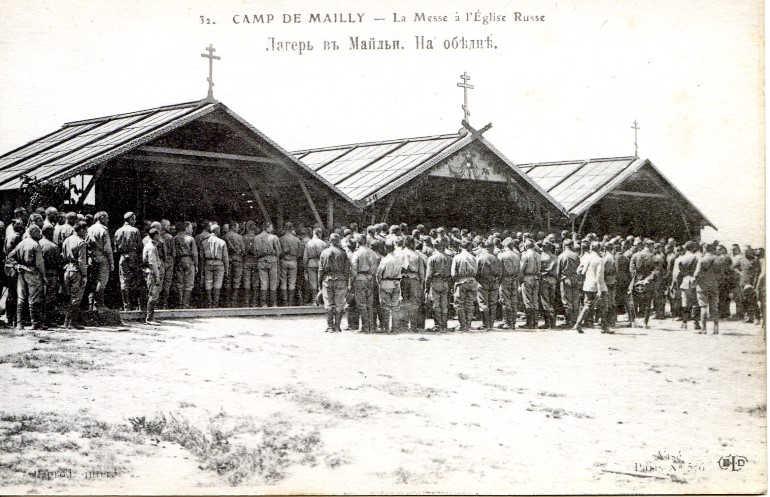
Camp in Mailly. At the Mass. Picture from René Guerre’s collection
The Russian Expeditionary Force debuted in the course of battles with the Germans near Champagne-Ardenne and Fort de la Pompelle, which is an entrance to Reims city at the northeast of the country. Informed by the intelligence the enemies deployed there its steel division of three brigades three days before the brigade’s arrival. The first battle turned a serious failure for the Germans. The second battle took place some time later. The enemies undertook a gas attack this time. The Groups of the Germans wearing gas masks advanced into the first defense line trenches. The soldiers of the Russian Expeditionary Force were bravely fighting. Their bayonets were hard to defeat. Eventually the enemies retreated bearing great losses.
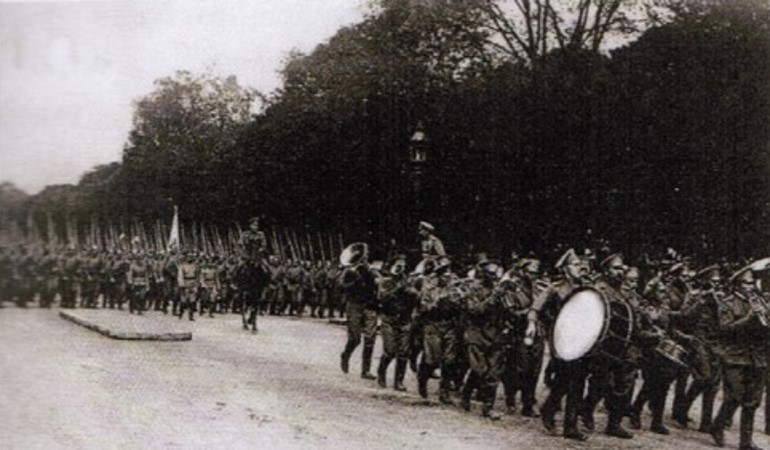
Russian Army at Champs Elysees. June 14 1916. Picture from René Guerre’s collection
The Russians stopped enemies’ troops by Reims in September 1916. They defended one of the national symbols of France - the Cathedral used for coronations of the French Kings since the 12th century. The Russian officers and soldiers of the Force won military glory and acknowledgement of their virtues in this and the following battles.
…. Year 1917 brought many mischievous changes. The news on Nicholas the Second’s renunciation, unskillful actions of the Provisional Government and duality of power concerning peace and war questions resulted in turmoil and controversies among the soldiers. The Bolsheviks’ regime and signature of the peace treaty of Brest led Russia out of the war.
Honorable Names of Russian soldiers
In the huddle of the events, the Russian Expeditionary Force was thrown in at the deep end. Calls for putting an end to the Imperial war and beat swords into plowshares were supported by the soldiers. The brigade commanders did not get any orders from the center. Messages which came after the February Revolution that all the main military divisions continue functioning as before were too vague.
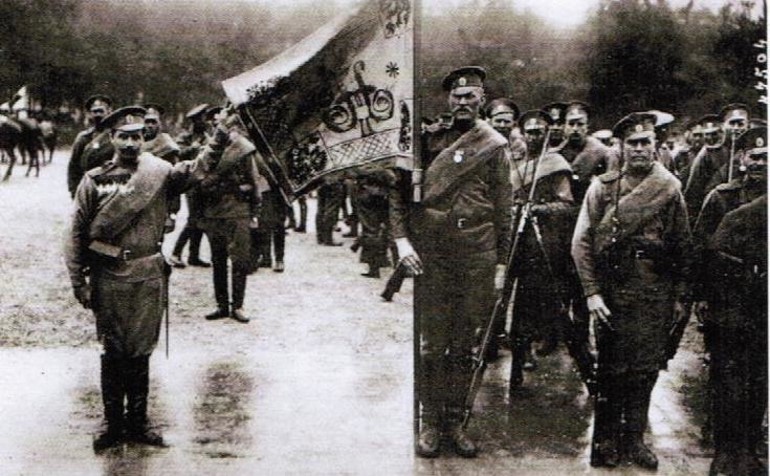
Russian flag in Paris. July 14 1916. Picture from René Guerre’s collection
Under these circumstances, the Russian military mission in Paris issued and announced an order to treat the Provisional Government as the Supreme Power and observe all the military laws until the changes–to-be as well as to keep honorable names of Russian officers and soldiers in the eyes of our allies.
Noteworthy that the author of the order is a military agent of the Russian General Headquarters in Paris Count A. A. Ignatyev who was hesitating at its signature. The following explanations were provided in his memoirs published later: “it is better to stay Russian and continue carrying out the duty for Russia in order to save the privileges necessary to go on waging the war and to save moral responsibility for France. It would be wise to mention that the French credited privileges necessary to wage the war were allocated due to sending the Russian Expeditionary Force.
On April 16, 1917 the troops were ordered to attack: “The time has come! Live long, France!”. The Russian forces bore responsibility for the key frontline patch. Soldiers decided to attack! Both Russian brigades fought – the first one in the northeastern sector of Reims, the second one – in the northwestern direction from Chalons. The honor of the Russian army was saved.
Russian Brigades song dedicated to the Russian soldiers and officers fighting in France during the First World War composed after the movie directed by Oleg Zaitsev under title Died for France. Author is Viktor Leonidov.
Russian legion
Meanwhile the worrying news from Russia and war losses intensified anti-war moods among the soldiers of the Expeditionary Force. Arrival of the Provisional Government’s representatives and their attempts to appease the soldiers came to a dead end. Both Russian brigades of rebels bearing huge losses after the April fights were sent out from the front line to the remote camping la Courtine and shot dead.
Forming battalions of Russian legionaries out of soldiers – volunteers started in December of 1917. At the beginning of the next year, 4 battalions consisted already of more than 1500 legionaries. The Russian legion arrives at the military zone and affiliates with famous Morocco strike division, the best in France. The military glory of this division was so huge and it was great honor to serve in it. The Russian legion demonstrated unseen bravery in the hardest battles.
Hard times came for the French in Spring of 1918. In accordance with data of the military historians, the French forces and its allies came short of the number of regiments. After the German divisions were thrown out of the Russian frontline, the armed forces of Germany comprised 195 divisions overall.
A contribution of the Russian legion was especially significant under the current circumstances of the military opposition. The Russian legion stopped the German troops from advancing to Paris at great losses in the battles on the River Somme in April of 1918, and in May and in September of 1918 near Soissons.
Morocco division targeted to save the capital faces the main attack in this battle. The enemy puts fresh soldiers into the fight forcing the French aside. At the very critical moment, when all seems to be lost, here comes the Russian legion as the last reserve.
The French mass media has widely broadcast heroism and self-sacrifice of the Russian soldiers in these battles. By the Commander-in-chief’s order, the Russian legion was handed out the Sign of Honor and awarded with the Order of the Military Cross, established by the French President for special military merits at the First World War. In August of 1918, the commander-in-chief of the French army Marshal Foch orders to attack. The joint stroke by the allied armies along the whole frontlines that followed put the beginning of the German catastrophe. Volunteers of the Russian legion finished the war at the territory of the defeated Germany. The victory signal to cease the fire came on November 11, 1918.
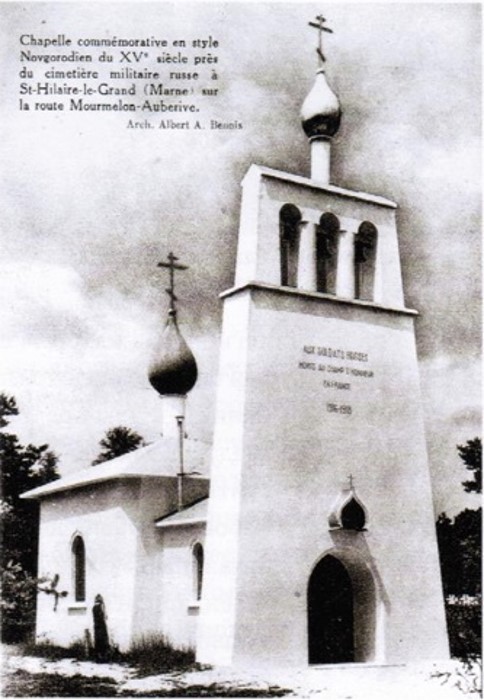
Memorial chapel in the Novgorod style of the 15th century at war memorial cemetery Mourmelon-le-Grand is monument to the Russian officers and soldiers who died in France at the battlefield (architect Albert A. Benois) A postcard issued by Association of the Russian officers – war veterans at the French frontline
History of Russian warriors fighting for freedom of France lives on thanks to the Russian compatriots living here and the care of the French about the Russian military cemeteries. The most well-known military cemetery is Saint-Hilaire-le-Grand near Mourmelon. The memorial cathedral of Christ’s Resurrection was erected in 1937 next to it at the soil bought by the Russian immigrant community according to the project of architect A.A. Benois. The note reads that the memorial cathedral does not belong to the officers of the Expeditionary Force only, they just guarded it. It belongs to all the Russians who value the glorious past of our great country. To keep this holy relic in a proper condition until the bright day of Russia’s Resurrection is duty of all Russian people.
New publications

 Mikhail Kalatozov, a director who transformed the world of cinematography in many ways, was born 120 years ago. He was a Soviet film official and a propagandist. Above all, he was capable of producing movies that struck viewers with their power and poetic language.
Mikhail Kalatozov, a director who transformed the world of cinematography in many ways, was born 120 years ago. He was a Soviet film official and a propagandist. Above all, he was capable of producing movies that struck viewers with their power and poetic language.  Ukrainian authorities have launched a persecution campaign against the canonical Ukrainian Orthodox Church (UOC), the biggest one in the country's modern history. Over the past year, state sanctions were imposed on clergy representatives, searches were conducted in churches, clergymen were arrested, criminal cases were initiated, the activity of the UOC was banned in various regions of the country, and monasteries and churches were seized.
Ukrainian authorities have launched a persecution campaign against the canonical Ukrainian Orthodox Church (UOC), the biggest one in the country's modern history. Over the past year, state sanctions were imposed on clergy representatives, searches were conducted in churches, clergymen were arrested, criminal cases were initiated, the activity of the UOC was banned in various regions of the country, and monasteries and churches were seized.  When Nektary Kotlyaroff, a fourth-generation Russian Australian and founder of the Russian Orthodox Choir in Sydney, first visited Russia, the first person he spoke to was a cab driver at the airport. Having heard that Nektariy's ancestors left Russia more than 100 years ago, the driver was astonished, "How come you haven't forgotten the Russian language?" Nektary Kotlyaroff repeated his answer in an interview with the Russkiy Mir. His affinity to the Orthodox Church (many of his ancestors and relatives were priests) and the traditions of a large Russian family brought from Russia helped him to preserve the Russian language.
When Nektary Kotlyaroff, a fourth-generation Russian Australian and founder of the Russian Orthodox Choir in Sydney, first visited Russia, the first person he spoke to was a cab driver at the airport. Having heard that Nektariy's ancestors left Russia more than 100 years ago, the driver was astonished, "How come you haven't forgotten the Russian language?" Nektary Kotlyaroff repeated his answer in an interview with the Russkiy Mir. His affinity to the Orthodox Church (many of his ancestors and relatives were priests) and the traditions of a large Russian family brought from Russia helped him to preserve the Russian language.

 The leaders of the Friends of the Great Russia cultural association (Amici Della Grande Russia) in Italy believe that the Western policy of abolishing Russian culture in Europe has finally failed. Furthermore, it was doomed to failure from the beginning.
The leaders of the Friends of the Great Russia cultural association (Amici Della Grande Russia) in Italy believe that the Western policy of abolishing Russian culture in Europe has finally failed. Furthermore, it was doomed to failure from the beginning.  Name of Vladimir Nemirovich-Danchenko is inscribed in the history of Russian theater along with Konstantin Stanislavski, the other founding father of the Moscow Art Theater. Nevertheless, Mr. Nemirovich-Danchenko was a renowned writer, playwright, and theater teacher even before their famous meeting in the Slavic Bazaar restaurant. Furthermore, it was Mr. Nemirovich-Danchenko who came up with the idea of establishing a new "people's" theater believing that the theater could become a "department of public education."
Name of Vladimir Nemirovich-Danchenko is inscribed in the history of Russian theater along with Konstantin Stanislavski, the other founding father of the Moscow Art Theater. Nevertheless, Mr. Nemirovich-Danchenko was a renowned writer, playwright, and theater teacher even before their famous meeting in the Slavic Bazaar restaurant. Furthermore, it was Mr. Nemirovich-Danchenko who came up with the idea of establishing a new "people's" theater believing that the theater could become a "department of public education."  "Russia is a thing of which the intellect cannot conceive..." by Fyodor Tyutchev are famous among Russians at least. December marks the 220th anniversary of the poet's birth. Yet, he never considered poetry to be his life's mission and was preoccupied with matters of a global scale. Mr.Tyutchev fought his war focusing on relations between Russia and the West, the origins of mutual misunderstanding, and the origins of Russophobia. When you read his works today, it feels as though he saw things coming in a crystal ball...
"Russia is a thing of which the intellect cannot conceive..." by Fyodor Tyutchev are famous among Russians at least. December marks the 220th anniversary of the poet's birth. Yet, he never considered poetry to be his life's mission and was preoccupied with matters of a global scale. Mr.Tyutchev fought his war focusing on relations between Russia and the West, the origins of mutual misunderstanding, and the origins of Russophobia. When you read his works today, it feels as though he saw things coming in a crystal ball...